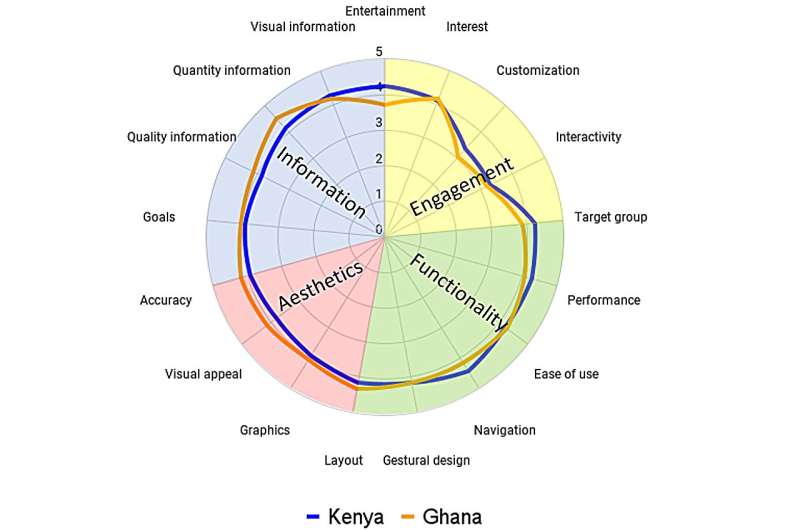This article has been reviewed according to Science X's editorial process and policies. Editors have highlighted the following attributes while ensuring the content's credibility:
fact-checked
peer-reviewed publication
trusted source
proofread
Evaluating a mobile app as a training tool to detect skin diseases

The Journal of Medical Internet Research has published the results from the first phase of the validation study on the SkinNTDs mobile app, which aims to help control neglected tropical diseases and some common skin diseases, which particularly affect countries with low per capita incomes.
The study is led by principal investigator at the eHealth Lab of the Universitat Oberta de Catalunya (UOC), Carme Carrion, who is also associate dean for research at the Faculty of Health Sciences, and fellow UOC researcher Mireia Cano, project manager at the office of innovation and cross-sectional processes at the Hospital Germans Trias i Pujol.
The validation project began in 2021 and is an assignment from the World Health Organization (WHO), owner of the application, developed by the Catalan company Universal Doctor. The results of this first phase show the good reception for the app among the professionals who have participated in the project in Ghana and Kenya. Phase two of the study kicked off this April with fieldwork in Kenya to validate the inclusion of artificial intelligence (AI) elements integrated into a new beta version of the app.
The article highlights the "good results in terms of usability," said Mireia Cano. These results are, according to the scaling parameters used by the researchers to evaluate the tool, "independent of the country, the person's experience in dermatology and the management of the diseases."
Additionally, noted Cano, we have seen that the positive reception "doesn't depend on participants' age or level of technological knowledge." For the UOC researcher, "this is very important, because the fact that there's no difference between the two countries (which have their similarities, but also differences) can bolster the hypothesis that the app doesn't have to be customized for each country, which makes it more scalable: it would only be a matter of translating it into each country's language," explained Cano.
Around 50 professionals on the ground
The first part of the study saw the participation of 50 professionals on the ground in Ghana and Kenya. The app seeks to help health care professionals improve their knowledge of 12 neglected tropical diseases and 24 common skin diseases, in terms of both diagnosis and treatment. The fact that the project started during the pandemic limited the contact with on-the-ground participants.
Now, though, fieldwork with the health professionals in Kenya will make it possible to work more closely together and continue with evaluation of the app's new AI-based features, which should facilitate the identification of diseases, leveraging two photograph-based algorithms.
Validating and improving photograph-based algorithms
This new phase of the project aims to check "the extent to which the app allows users to identify a set of diseases accurately," explained Carme Carrion. The two experts will hold preliminary seminars to explain the project and how to use the tool.
Over the course of two months, when professionals participating in the project find people affected by skin diseases, they will perform their diagnosis and, at the same time, ask the app for its assessment. The result will be sent to a WHO platform where two dermatologists, from Tunisia and Kenya, will perform their own diagnosis, without knowing the result shown by the AI, and this will then be compared with that of the algorithms. This will help establish if it is accurate enough.
"Until now the application, which has been designed in all cases as a training tool for professionals and not as a medical diagnostic device, had a logical algorithm that used a list of signs and symptoms. Now, however, with AI, the results are expected to permit additional information to be obtained, based on each individual patient's lesion," noted Carrion.
Working to improve the diagnosis of these diseases is, stressed Carrion, very important in low- and middle-income countries, which is why it is essential to have "digital tools for people in rural areas who aren't specialists in dermatology," which is usually the case in most of these countries.
The WHO, explained Carrion, "is strongly committed to mobile health as a means of improving access to the health care system." Phase two of the study seeks to secure 250 to 500 cases on the ground, with photographs that will be used to evaluate the AI algorithms and ascertain the opinions of the health care professionals who will be using the app.
More information: Mireia Cano et al, Evaluating the World Health Organization's SkinNTDs App as a Training Tool for Skin Neglected Tropical Diseases in Ghana and Kenya: Cross-Sectional Study, Journal of Medical Internet Research (2024). DOI: 10.2196/51628





















